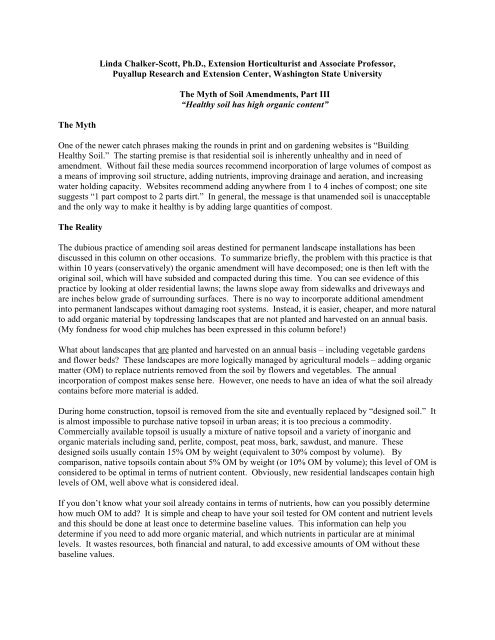The Myth of Soil Amendments, Part III - Puyallup Research ...
The Myth of Soil Amendments, Part III - Puyallup Research ...
The Myth of Soil Amendments, Part III - Puyallup Research ...
Create successful ePaper yourself
Turn your PDF publications into a flip-book with our unique Google optimized e-Paper software.
Linda Chalker-Scott, Ph.D., Extension Horticulturist and Associate Pr<strong>of</strong>essor,<br />
<strong>Puyallup</strong> <strong>Research</strong> and Extension Center, Washington State University<br />
<strong>The</strong> <strong>Myth</strong> <strong>of</strong> <strong>Soil</strong> <strong>Amendments</strong>, <strong>Part</strong> <strong>III</strong><br />
“Healthy soil has high organic content”<br />
<strong>The</strong> <strong>Myth</strong><br />
One <strong>of</strong> the newer catch phrases making the rounds in print and on gardening websites is “Building<br />
Healthy <strong>Soil</strong>.” <strong>The</strong> starting premise is that residential soil is inherently unhealthy and in need <strong>of</strong><br />
amendment. Without fail these media sources recommend incorporation <strong>of</strong> large volumes <strong>of</strong> compost as<br />
a means <strong>of</strong> improving soil structure, adding nutrients, improving drainage and aeration, and increasing<br />
water holding capacity. Websites recommend adding anywhere from 1 to 4 inches <strong>of</strong> compost; one site<br />
suggests “1 part compost to 2 parts dirt.” In general, the message is that unamended soil is unacceptable<br />
and the only way to make it healthy is by adding large quantities <strong>of</strong> compost.<br />
<strong>The</strong> Reality<br />
<strong>The</strong> dubious practice <strong>of</strong> amending soil areas destined for permanent landscape installations has been<br />
discussed in this column on other occasions. To summarize briefly, the problem with this practice is that<br />
within 10 years (conservatively) the organic amendment will have decomposed; one is then left with the<br />
original soil, which will have subsided and compacted during this time. You can see evidence <strong>of</strong> this<br />
practice by looking at older residential lawns; the lawns slope away from sidewalks and driveways and<br />
are inches below grade <strong>of</strong> surrounding surfaces. <strong>The</strong>re is no way to incorporate additional amendment<br />
into permanent landscapes without damaging root systems. Instead, it is easier, cheaper, and more natural<br />
to add organic material by topdressing landscapes that are not planted and harvested on an annual basis.<br />
(My fondness for wood chip mulches has been expressed in this column before!)<br />
What about landscapes that are planted and harvested on an annual basis – including vegetable gardens<br />
and flower beds? <strong>The</strong>se landscapes are more logically managed by agricultural models – adding organic<br />
matter (OM) to replace nutrients removed from the soil by flowers and vegetables. <strong>The</strong> annual<br />
incorporation <strong>of</strong> compost makes sense here. However, one needs to have an idea <strong>of</strong> what the soil already<br />
contains before more material is added.<br />
During home construction, topsoil is removed from the site and eventually replaced by “designed soil.” It<br />
is almost impossible to purchase native topsoil in urban areas; it is too precious a commodity.<br />
Commercially available topsoil is usually a mixture <strong>of</strong> native topsoil and a variety <strong>of</strong> inorganic and<br />
organic materials including sand, perlite, compost, peat moss, bark, sawdust, and manure. <strong>The</strong>se<br />
designed soils usually contain 15% OM by weight (equivalent to 30% compost by volume). By<br />
comparison, native topsoils contain about 5% OM by weight (or 10% OM by volume); this level <strong>of</strong> OM is<br />
considered to be optimal in terms <strong>of</strong> nutrient content. Obviously, new residential landscapes contain high<br />
levels <strong>of</strong> OM, well above what is considered ideal.<br />
If you don’t know what your soil already contains in terms <strong>of</strong> nutrients, how can you possibly determine<br />
how much OM to add? It is simple and cheap to have your soil tested for OM content and nutrient levels<br />
and this should be done at least once to determine baseline values. This information can help you<br />
determine if you need to add more organic material, and which nutrients in particular are at minimal<br />
levels. It wastes resources, both financial and natural, to add excessive amounts <strong>of</strong> OM without these<br />
baseline values.
Last fall we collected soil samples from a local organic demonstration garden and sent them out for<br />
nutrient analysis; this garden had recently experienced some soil and plant health problems. Every single<br />
one <strong>of</strong> the sites that was tested came back with nutrient readings <strong>of</strong>f the scale. In large capital letters the<br />
report warned “DO NOT FERTILIZE THIS SOIL.” <strong>The</strong> excessive addition <strong>of</strong> nutrient-rich compost to<br />
this landscape contributed not only to plant health problems but to nutrient loading <strong>of</strong> adjacent natural<br />
waters.<br />
<strong>The</strong> Bottom Line<br />
• Ideal soils, from a fertility standpoint, are generally defined as containing no more than 5% OM<br />
by weight or 10% by volume<br />
• Before you add organic amendments to your garden, have your soil tested to determine its OM<br />
content and nutrient levels<br />
• Be conservative with organic amendments; add only what is necessary to correct deficiencies and<br />
maintain OM at ideal levels<br />
• Do not incorporate organic amendments into landscapes destined for permanent installations;<br />
topdress with mulch instead<br />
• Abnormally high levels <strong>of</strong> nutrients can have negative effects on plant and soil health<br />
• Any nutrients not immediately utilized by microbes or plants contribute to non-point source<br />
pollution<br />
For more information, please visit Dr. Chalker-Scott’s web page at http://www.theinformedgardener.com.
















